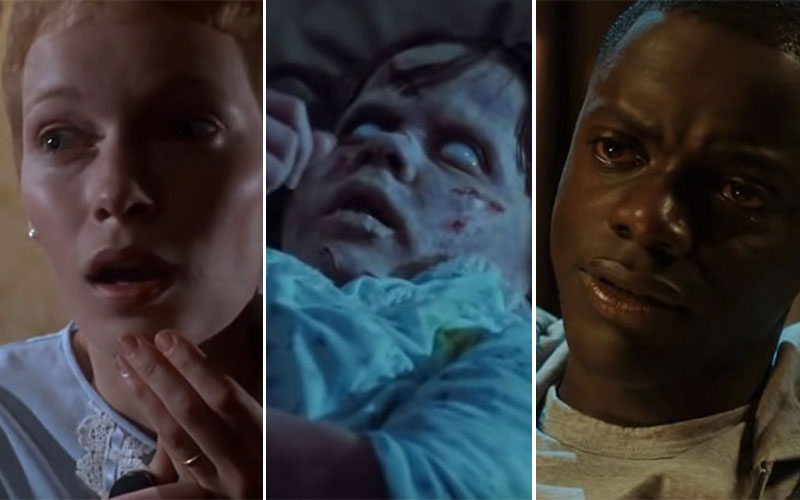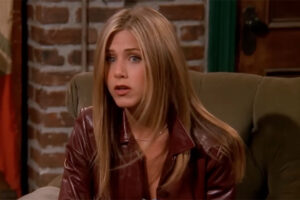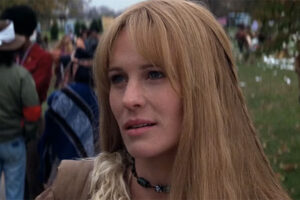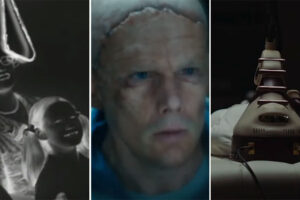
Horror movies have the power to haunt us long after the credits roll and while jump scares can be effective, true terror often lies in the psychological and atmospheric elements of a film. Here’s a list of 10 terrifying movies that go beyond cheap jump scares to deliver bone-chilling experiences
The Babadook

Jennifer Kent’s “The Babadook” is a psychological horror that explores the depths of grief and maternal turmoil. It centers on a single mother, plagued by the violent and disturbing manifestations of a sinister children’s book character called the Babadook.
The film’s brilliance lies in its metaphorical approach to horror, making the supernatural entity a representation of the mother’s psychological torment. This unsettling exploration of motherhood and the darkness within is sure to linger in your mind long after watching.
Hereditary

Hereditary builds a lingering sense of dread from the start. Toni Collette gives a powerhouse performance as a woman dealing with grief, family secrets, and creeping terrors that escalate to outright horror by the end. The film’s scariest moments come from nuanced performances and oppressive cinematography, not cheap thrills. Audiences are chilled to the bone by the time the unforgettable final scene arrives.
The terrifying imagery, unsettling sound design, and Toni Collette’s powerhouse performance elevate “Hereditary” to a level of horror that resonates long after the credits roll.
The Witch

The foreboding atmosphere of The Witch oozes off the screen from the first shot. Taking place in 17th century New England, a puritanical family unravels when the youngest child goes missing and a sinister witch lurks in the woods.
This atmospheric horror film excels in its eerie setting, slow-burning tension, and deeply unsettling religious overtones. It’s a chilling exploration of family dynamics and the psychological terror that can arise from fear of the unknown.
The Blackcoat’s Daughter

Moody cinematography and an ethereal score by the late Jóhann Jóhannsson create an atmospheric slow burn in The Blackcoat’s Daughter. Kiernan Shipka shines as a boarding school student left behind over break as increasing signs of a satanic presence emerge. The movie creeps under your skin with palpable dread and ambiguity about the evil forces at play. When the violence finally erupts, the restrained buildup makes it all the more shocking.
While jump scares have their place, these psychological slow-burn horror films prove true terror comes from tension, imagery, and inheriting a sense of grim inevitability. Leaving audiences unsettled long after the movie ends, these 5 films are scarier than the groundbreaking classic The Exorcist.
Get Out

Jordan Peele’s directorial debut, “Get Out,” blends horror with social commentary, resulting in a profoundly unsettling experience.
The film follows an African-American man visiting his white girlfriend’s family for a weekend, only to uncover disturbing secrets about their true intentions.
Masterful writing and direction by Jordan Peele takes common racial anxieties and magnifies them to terrifying heights through brilliant twists. The chilling suspense and profound messages make it a haunting masterpiece.
The Blair Witch Project

“The Blair Witch Project” is a found-footage horror film that revolutionized the genre and set a new standard for realism in horror.
The movie follows three student filmmakers who venture into the Black Hills Forest to document the legend of the Blair Witch. As they get lost in the woods, strange occurrences intensify, and tensions rise among the group.
The brilliance of the film lies in its minimalistic approach and the feeling of helplessness it creates. By leaving much to the imagination, it taps into our primal fear of the unknown and the unsettling feeling of being lost and pursued. The documentary-style presentation adds a chilling touch of authenticity that makes it feel all too real.
Rosemary’s Baby

Roman Polanski’s “Rosemary’s Baby” is a classic psychological horror that delves into the paranoia of pregnancy and the fear of the unknown.
The story follows Rosemary, a pregnant woman who becomes increasingly suspicious of her neighbors and husband’s intentions as her pregnancy progresses.
The film expertly builds tension and unease, as the audience is unsure whether Rosemary’s fears are real or just the result of her fragile mental state. The slow and deliberate pacing allows the horror to unfold gradually, making it an unsettling exploration of psychological terror and manipulation.
The Silence of the Lambs

While “The Silence of the Lambs” is primarily a thriller, its horror elements are undeniably terrifying. Directed by Jonathan Demme, the film follows Clarice Starling, an FBI trainee seeking the help of the brilliant but insane psychiatrist and cannibalistic serial killer, Dr. Hannibal Lecter, to catch another serial killer known as Buffalo Bill.
The film’s strength lies in its masterful performances, particularly Anthony Hopkins as Hannibal Lecter, who exudes a chilling intelligence and charisma. The psychological cat-and-mouse game between Clarice and Lecter adds an intense layer of suspense, while the gruesome and unsettling scenes contribute to the overall horror experience.
The Shining

Directed by the legendary Stanley Kubrick, “The Shining” is a masterpiece of psychological horror that has stood the test of time. Based on Stephen King’s novel, the film follows Jack Torrance, a struggling writer, who becomes the off-season caretaker of the isolated Overlook Hotel with his family. As the supernatural forces within the hotel start to take hold of Jack’s sanity, the once-friendly building turns into a nightmarish labyrinth of terror.
“The Shining” is a slow and methodical descent into madness, with Kubrick’s signature style of meticulous filmmaking creating an atmosphere of unease and foreboding. Jack Nicholson’s iconic portrayal of Jack Torrance is hauntingly brilliant, as he embodies a man on the edge of insanity. The film’s unsettling imagery, eerie soundtrack, and surreal sequences, like the blood-filled elevator, the twins and the infamous “Here’s Johnny!” scene, have become cultural touchstones of horror.
The Exorcist

“The Exorcist,” directed by William Friedkin, is a horror classic that redefined the genre and remains one of the most terrifying films ever made. The psychological tension and grim inevitability make it truly terrifying. Adapted from William Peter Blatty’s novel, the story revolves around a young girl named Regan who becomes possessed by a malevolent and demonic entity. As her mother seeks help from two priests, they engage in a battle against evil, pushing the boundaries of faith and confronting their own inner demons.
What sets “The Exorcist” apart is its focus on psychological and spiritual horror, rather than relying solely on jump scares. The film builds tension gradually, drawing the audience into the eerie atmosphere of the haunted house. The chilling sound design, haunting visuals, and unsettling practical effects create an intense and unsettling experience.
Linda Blair’s portrayal of the possessed Regan is nothing short of phenomenal, adding to the disturbing nature of the film. Her transformation from an innocent girl to a vessel of terror is both shocking and heartbreaking, leaving a lasting impression on viewers.










Leave a Reply